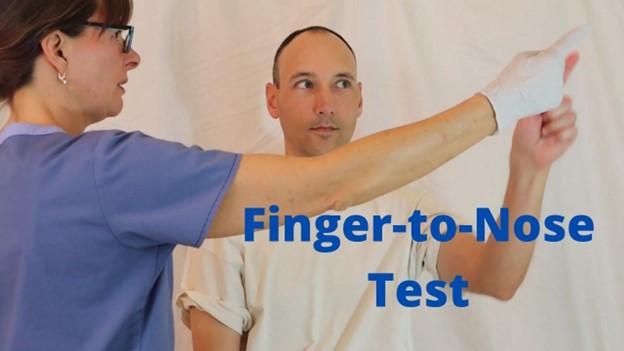A nurse is performing a focused assessment of a client's sensory functions. Which of the following tests should the nurse perform?
Walking gait test.
Plantar reflex test.
Finger-to-nose test.
Romberg test.
The Correct Answer is C
Choice A rationale:
The walking gait test is used to assess a client's walking pattern and balance, particularly for identifying abnormalities in gait. However, it doesn't specifically evaluate sensory functions, making it an inappropriate choice for this scenario.
Choice B rationale:
The plantar reflex test, also known as the Babinski reflex test, assesses the neurological integrity of the corticospinal tract. It involves stimulating the sole of the foot to elicit specific reflex movements. While this test is important in assessing neurological function, it doesn't directly evaluate sensory functions as requested in the question.
Choice C rationale:
The finger-to-nose test is a part of the neurological examination used to assess a client's coordination and proprioception. In this test, the client is asked to touch their nose with their index finger while alternating between eyes closed and eyes open. This evaluates their ability to sense the position of their limbs in space (proprioception) and their coordination. It directly addresses the focus of the question, making it the correct choice.

Choice D rationale:
The Romberg test evaluates a client's balance and proprioception. It involves having the client stand with their feet together and their eyes closed to assess their ability to maintain balance without visual input. While this test is relevant to sensory functions, it primarily assesses proprioception and balance rather than coordination, which the question is specifically targeting.
Nursing Test Bank
Naxlex Comprehensive Predictor Exams
Related Questions
Correct Answer is C
Explanation
Choice A rationale:
Peer pressure (Choice A) is an external stressor, as it involves the influence of others on an individual's thoughts or actions. It originates from outside the individual and is not directly related to an internal psychological response.
Choice B rationale:
Death of a family member (Choice B) is an external stressor, as it is an event that occurs externally to the individual. While it can cause significant emotional distress, it is not considered an internal stressor.
Choice C rationale:
Fear of medical test results (Choice C) is the correct answer as an internal stressor. Internal stressors are psychological or emotional factors that originate within the individual and contribute to stress. Fear of medical test results is a personal worry that can lead to anxiety and emotional turmoil.
Choice D rationale:
Job transfer to another city (Choice D) is an external stressor, as it involves a change in the individual's external environment. It is not an internal psychological factor causing stress.
Correct Answer is B
Explanation
Choice A rationale:
Selecting an injection site on the abdomen 5 cm (2 in) from the umbilicus might be an appropriate instruction for some subcutaneous injections, but the specific injection site can vary based on the medication and client's needs. This choice is not a universal instruction for all subcutaneous injections.
Choice B rationale:
Expelling the air bubble from a prefilled syringe before injecting the medication is essential to ensure accurate dosing. Air bubbles can displace medication and lead to underdosing. This step is crucial for safe and effective administration.
Choice C rationale:
Aspirating prior to injecting medication is a technique used for intramuscular injections to ensure the needle is not in a blood vessel. However, for subcutaneous injections, aspirating is not necessary or recommended, as it can cause tissue damage and discomfort.
Choice D rationale:
Inserting the needle at a 15° angle is not a standard practice for subcutaneous injections. Subcutaneous injections are typically administered at a 45° or 90° angle, depending on the needle length and client's body composition. A 15° angle would not ensure proper medication delivery.
Whether you are a student looking to ace your exams or a practicing nurse seeking to enhance your expertise , our nursing education contents will empower you with the confidence and competence to make a difference in the lives of patients and become a respected leader in the healthcare field.
Visit Naxlex, invest in your future and unlock endless possibilities with our unparalleled nursing education contents today
Report Wrong Answer on the Current Question
Do you disagree with the answer? If yes, what is your expected answer? Explain.
Kindly be descriptive with the issue you are facing.
